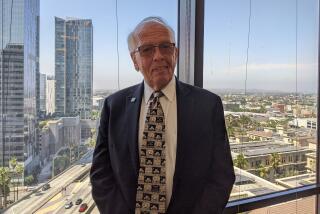Emergency in L.A.’s Medical Care
- Share via
After repeated warnings and dire predictions, the crisis in emergency medical services is finally upon Los Angeles. With the downgrading of emergency departments at California, Good Samaritan, French and Linda Vista hospitals, and the anticipated withdrawal of Hollywood Presbyterian and possible withdrawal of Queen of Angels and White Memorial hospitals from the system, a vast area of our city, where perhaps a million people live, will not be within close range of an emergency department.
If the critically ill and injured cases now being treated at the withdrawing hospitals are all transported to a county hospital or one of the remaining private hospitals, they will unquestionably overwhelm those facilities. As it is right now, our county hospitals are scandalously overloaded. On a Saturday night paramedics frequently cannot find stretchers where they can unload their patients in the emergency department at Martin Luther King Jr. Patients wait for hours for emergency surgery at Los Angeles County-USC Medical Center.
Faced with the added load imposed by withdrawal of private hospitals from the system, officials in the county Department of Health Services don’t know what to do. Indeed, there is little they can do. Public hospitals can’t carry the load alone; private institutions, having given fair warning, are preparing to pull out of what has been largely a private-hospital-based system. There will be “excess mortality”--people are going to die. They will die as the result of excessively long transport times and they will die when the hospitals they reach cannot care for them.
The root of the problem is money and public policy. Private hospitals have seen a striking increase in the number of persons who cannot pay for their care. In Los Angeles County in 1987, 26% of the population had no health insurance--a significant increase over past years. Despite the increased demand for uncompensated services, hospitals have been squeezed by the government and private insurers, who are paying much leaner daily fixed rates, or fixed amounts per diagnosis. Government protestations aside, hospitals are being hurt, and hospitals in poorer areas hurt worst.
An administrator recently told me that if his hospital admits a poor patient to the intensive-care unit (half the emergency admissions go to intensive-care or coronary-care units), the hospital uses up its entire Medi-Cal (the state-federal aid program for the poor) per-diem in the first 12 hours on nursing care alone, leaving no reimbursement for surgery, CAT scans, drugs, monitors and other essential services. No wonder central-city hospitals, whose patient loads are 30%-40% Medi-Cal patients, try to curtail admissions to intensive-care units.
In the past, hospitals shifted excess reimbursements from private insurance to cover the cost of caring for the poor. Now, with the government leading the way, private insurers are demanding that hospitals agree to daily rate payments that will not permit such cost-shifting. With the government unwilling to subsidize care of the poor, private insurers, and indeed hospitals, have begun to put limits on their social obligations.
Faced with a financial threat to their existence, the hospitals first sought to solve the problem in negotiations with Medi-Cal officials in Sacramento and the Health Care Finance Administration in Washington. When that failed they tried public appeals--last November they published a survey conducted by the Hospital Council of Southern California and the Los Angeles County Medical Assn., which showed that private hospitals alone were losing $6.8 million per month by subsidizing care of the poor. Most of that was sustained by a few hospitals central to the poverty areas of the city. The report generated little public interest and no government response.
Hospitals have now taken action to protect themselves. They have downgraded their emergency services to “standby” status, a designation that makes them ineligible to receive ambulances bringing the indigent and uninsured.
This would make little difference to the general public if we had a public hospital system capable of carrying the load. Unfortunately, county hospitals are in sad shape. They were under-funded in the 1970s when I trained in the system, and they have not been upgraded to deal with the increase in population, the number of uninsured, the indigents, the illegal immigrants or the increased cost of current standards of care.
The conservative majority on the Los Angeles County Board of Supervisors and Gov. George Deukmejian are widely criticized for seeming to regard money spent on health care for the poor as money wasted. It is no accident that California’s Medi-Cal (nationally the program is called Medicaid) is 47th of the 50 states in level of funding, and it is no accident that we have not allocated enough money on a county level to prevent a syphilis epidemic, or teach AIDS prevention or build county hospitals and clinics capable of caring for the poor as required by state law.
The budgets adopted by the governor and Board of Supervisors represent, in fact, a change in public policy--one implemented by fiat, undebated and unannounced. This policy, in turn, is based upon their belief that health-care cost in general and health care for the poor in particular is uncontrollable and insatiable.
Total health care costs in the United States currently exceed 11% of the gross domestic product, more than twice what they were a generation ago. In the eyes of many, the Medi-Cal budget, if not controlled, could bankrupt the state. Politicians, seeing doctors and hospitals as fat and inefficient, have systematically cut the reimbursement, figuring that would solve their problem. In fact, it has only brought us to the current crisis, which seriously threatens the health and safety of our citizens and will damage the reputation of our community. Unless we intervene decisively to reverse the process already under way, the collapse of our emergency medical systems will result in a standard of care that does not approach that of the 1940s and 1950s. Our pre-hospital care system will soon not meet the standards of many Third World countries.
How can we halt the process? The solutions are both political and financial.
A high-level group is needed to examine the problem and negotiate a solution. The Board of Supervisors and the City Council, with good will and cooperation, must agree to the formation of a panel containing representatives of involved institutions and agencies--the Hospital Council of Southern California, the county Department of Health Services, the city Fire Department, the County Medical Assn., state Department of Health Services, California Emergency Medical Services Agency and private industry. It would have greater impact if a person of stature in the community could be persuaded to chair the deliberations.
Hospitals should, in turn, agree to a reversal of the downgrading of emergency departments for a short period, perhaps 90 days.
The political task will not be easy, particularly because of funding restrictions imposed by Proposition 13 and the Gann Amendment. Sacramento must realize this is a state problem, too. If the emergency-care system and public hospitals collapse in Los Angeles, and Californians needlessly die, the state will not be able to disavow knowledge or responsibility--others will not see it as a “local issue,” particularly after it is clear that the state has not met its obligation to to health care for the indigent and uninsured.
No solution to the problem is likely, however, unless the governor directs his subordinates to change their behavior and deal realistically with the roots of this crisis. The county health bureaucracy will have to come to grips with the fact that we have allowed our public hospitals to fall into a state of inadequacy which daily forces unethical choices on those who care for the poor.
Organized medicine will have to help society live within a reasonable health-care budget, assigning priorities to expenditures and agreeing to use a fixed budget in order of priority--rationing services, in other words. Heavy emphasis should be placed on health education, preventive care and very basic services, while expensive tests, treatments and procedures will be available if budget allows. The budget then will be controllable, and the decision not to use a given treatment or technology in a particular case will not rest solely on an individual physician or hospital, but be based on public policy.
Organized medicine will then have to work to identify physicians who misuse the system, both within and outside organized medicine. Hospitals will have to agree to work within a prioritized, budgeted health-care system, at least as far as the poor are concerned.
Broad-based public support is essential. The notion that this is an isolated inner-city problem of indigents, homeless and immigrants is wrong on several counts:
The 26% of the population that is medically uninsured include many working people--minimum-wage workers like fast-food employees, salespersons and manual laborers, and such professionals as nurses and tradespeople who have simply not obtained health insurance.
The 74% with insurance will suffer along with the medically indigent if they are unlucky enough to fall ill or be injured far from emergency facilities--and that figures to be a large area.
The problem is likely to spread, as people in the under-served areas move to more affluent parts of town seeking uncompensated care, thus threatening currently viable hospitals.
To see people die of neglect in a society as rich as ours calls into question our social values and the competence and veracity of our leaders. We should be wise enough to move quickly for a solution.
More to Read
Sign up for Essential California
The most important California stories and recommendations in your inbox every morning.
You may occasionally receive promotional content from the Los Angeles Times.










